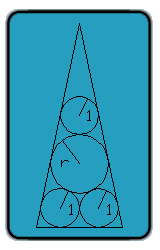The tangent line along one side from the single 1-unit-radius circle to the radius-r circle makes an angle with the central line of arcsin((r-1)/(r+1)), as the tangent line itself, plus perpendiculars along the radii for a length of 1 unit, touches the center of the unit circle and leaves (r-1) to go along the r-radius circle, and the angle that one side of the rectangle makes with the center line is the same as the other. The hypotenuse of the triangle is length r+1, so the sine of the angle at the center of the single 1-unit circle is (r-1)/(r+1).
The distance from the center of the radius-r circle to where the two 1-unit circles are tangent to the center line is sqrt((1+r)^2-1), so the angle from the center if the solitary unit circle to the center of one of the pair of unit circles has tan equal to 1/(sqrt((1+r)^2-1)+r+1)
Setting cells A1 through F1 to
1.1, =SQRT((1+A1)^2-1), =(A1-1)/(A1+1), =1/(B1+A1+1), =D1/SQRT(1+D1^2), =E1-C1, they represent the initial guess for r, the distance from the center of the radius-r circle to the tangent point of the unit circle pair, the sine of the first angle, the tangent of the second angle and the sine of the second angle, and finally the difference between the two sines.
The two angles must equal in order for this to be one exterior triangle. We use Excel's solver to vary cell A1 to make F1 be zero. Being careful to set the accuracy high enough, we get cell A1 to be 1.51067547264613, being the value of r to produce the triangle.
|
|
Posted by Charlie
on 2003-10-21 10:35:16 |




